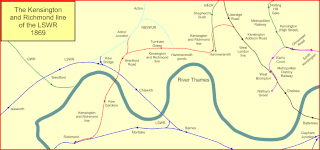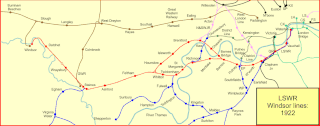Related Research Articles

The North London line is a railway line which passes through the inner suburbs of London, England between Richmond in the south-west and Stratford in the east, avoiding central London. Its route is a rough semicircle.

Snow Hill tunnel is a railway tunnel on the northern edge of the City of London which carries the up and down Snow Hill lines between City Thameslink and Farringdon stations. The tunnel runs beneath the Smithfield meat market and was constructed, using the cut-and-cover method, immediately prior to the building of the market. The tunnel opened on 1 January 1866.

Uxbridge High Street railway station in Uxbridge, England, was on what is now Oxford Road near its junction with Sanderson Road. It was the southern terminus and only station on the Great Western Railway (GWR) branch line from the GWR/GCR joint line, which is now the Chiltern Main Line.

The West London line (WLL) is a railway line in inner West London that links Willesden Junction in the north to Clapham Junction in the south. The line has always been an important cross-London link, especially for freight services. Southern and London Overground provide regular passenger services; detailed below.

The Eden Valley Railway (EVR) was a railway in Cumbria, England. It ran between Clifton Junction near Penrith and Kirkby Stephen via Appleby-in-Westmorland.

The Buckley Railway was opened from Buckley to a connection with the Chester to Holyhead main line on 7 June 1862, to convey coal and finished brickworks products from the Buckley area. Numerous short tramroads had existed in the area from the 1700s. The line was steeply graded and sharply curved.

Kew Bridge railway station is a railway station in Brentford, the London Borough of Hounslow, and is in Travelcard Zone 3. The station and all trains serving it are operated by South Western Railway. The station was named after the nearby Kew Bridge.

The Varsity Line was the main railway line that linked the English university cities of Oxford and Cambridge, operated by the London and North Western Railway.
The Bristol Port Railway and Pier was a railway in Bristol, England.
The Oxford, Worcester and Wolverhampton Railway (OW&WR) was a railway company in England. It built a line from Wolvercot Junction near Oxford to Worcester, Stourbridge, Dudley and Wolverhampton, as well as some branches. It was known locally as the "Old worse & worse" due to the acronym of its name (OW&W).
The Aberystwith and Welsh Coast Railway was a standard gauge railway company, running a line along the west coast of Wales.

The Chertsey branch line is a 5-mile-40-chain (8.9 km) railway line in Surrey, England. It runs from the Waterloo–Reading line at Virginia Water station to a triangular junction with the South West Main Line near Weybridge. There are intermediate stations at Chertsey and Addlestone. All of the stations are managed by South Western Railway, which operates all passenger trains. Most services run between Weybridge and London Waterloo via Hounslow and Clapham Junction. For much of the day, passengers can change to faster services at Virginia Water and Weybridge to reach the capital more quickly.

The Dudding Hill Line is a railway line in west and north-west London running from Acton to Cricklewood. It is roughly 4 miles (6.4 km) long, with a 30 miles per hour (48 km/h) speed limit, and semaphore signalling. The line has no scheduled passenger service, no stations, and is not electrified. It is lightly used by freight trains and, very occasionally, passenger charter trains.
There are 22 disused railway stations on the Bristol to Exeter line between Bristol Temple Meads and Exeter St Davids. The line was completed in 1844 at which time the temporary terminus at Beambridge was closed. The most recent closure was Tiverton Junction which was replaced by a new station} on a different site in 1986. 12 of the disused stations have structures that can still be seen from passing trains.
The North and South Western Junction Railway (NSWJR) was a short railway in west London, England. It opened in 1853, connecting Willesden on the London and North Western Railway (LNWR) with Brentford on the London and South Western Railway (LSWR). After a difficult start it became an important freight route and that usage continues today. A passenger service linked LSWR stations with the North London Railway, and a branch was built to Hammersmith.

Harlesden railway station was a station in northwest London on the south side of the southern section of a road called Craven Park, which is part of the A404 Harrow Road between Paddington and Wembley. The station was sometimes known as Harrow Road or as Stonebridge Park.

The Acton–Northolt line (ANL), otherwise known as the New North Main Line (NNML), is a railway line in West London, England. Built between 1903 and 1906, it runs from the Great Western Main Line at Old Oak Common TMD to the Chiltern Main Line at South Ruislip, alongside the West Ruislip branch of the London Underground Central line, for a distance of around 11 miles (18 km).

Westerleigh Junction is a railway junction in Gloucestershire, England, where the Cross Country Route (XCR) from York to Bristol Temple Meads meets the South Wales Main Line (SWML) from London Paddington to Swansea, near the village of Westerleigh.

The Kensington and Richmond line was a railway in West London, England. It was built by the London and South Western Railway, which already had a main line to Richmond from London. The Kensington line was chiefly a defensive measure to limit the incursion of rival railways into LSWR territory. It ran from Kensington on the West London Railway, by way of Hammersmith, Turnham Green, Gunnersbury and Kew; it opened in 1869. It had a separate station at Richmond, in keeping with the LSWR intention of preventing competitors from easily obtaining running powers to go further into the LSWR area.

The Windsor lines of the London and South Western Railway ran from Waterloo to Windsor via Richmond, with a loop via Hounslow. They started as the Richmond Railway, a simple independent branch line, but they developed a distinct identity and had their own approach to Waterloo alongside the Main Lines, and a distinct section of Waterloo station. The Richmond Railway was extended to Windsor by the Windsor, Staines, and South Western Railway; the company built a loop line via Hounslow in addition. Both independent companies were absorbed into the LSWR.
References
- ↑ Forgotten Stations of Greater London by J.E.Connor and B.Halford (page 54)
- ↑ London Railway Atlas 5th Edition by Joe Brown p.37
- ↑ West London Orbital p.16